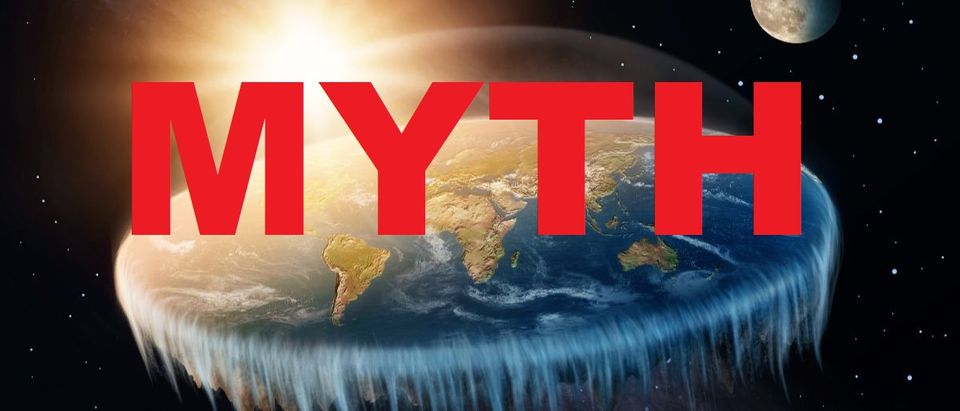In the National Archaeological Museum of Naples, a marble statue (which dates from the second century A.D. and is known as the “Farnese Atlas”) shows a Titan holding the heavens on his shoulders. It’s a Roman copy of an earlier Greek original. The muscles strain, the face is a grimace — and the shape of the heavens is a globe.
There are many views on what that is. Likely, it’s the earth around which the stars circle. But if common wisdom is believed, that before Christopher Columbus people thought the earth was flat, then Atlas should really have a large tray over his shoulder, like a busy waiter.
In our age of abuse and misuse of history, fiction often obscures fact; intentionally so, because fiction is a better handmaid to ideology. Truth tends to be destructive.
But Atlas’ globe tells a more fascinating tale, for it’s a summary of what the ancient world knew about the earth as a planet. They had mapped it, studied its lifeform and knew its circumference (Eratosthenes, in the third century B.C., measured it at 37,487 kilometers. The current estimate is 40,140 kilometers. The slight difference is likely because of our own faulty understanding of Greek quantifications).
There are other references to globes in Classical scientific literature, such as, the one made by Crates of Mallos, in about 150 B.C., which had a 10-foot diameter. Greek learning changed the world, and all of our own habits of mind are conditioned by this change.
Nor did Classical wisdom vanish (as commonly assumed); rather, it passed into medieval science (for example, the armillary sphere of Pope Sylvester II, and the work on longitudes and latitudes by Roger Bacon).
Therefore, Columbus knew Eratosthenes’s determination, and he also had with him Toscanelli’s accurate map (Toscanelli was schooled in Greco-Roman cartography). In fact, no one doubted that Columbus would reach Asia by sailing West. They just weren’t sure if ships could survive such a long ocean voyage, or if he was really the man for the job, or if there was a land mass in-between.
In the lengthy and rich history of Classical and medieval science, just five very obscure men claimed the earth was like a pancake. They were ignored as kooks even in their own day and really should be recognized as the Founding Fathers of the Flat Earth Society.
But in the nineteenth century, two of these five men (Lactantius and Indicopleustes) were chosen to represent all of Classical and medieval science. The enormity of this intellectual fraud is obvious. Thus begins the Flat Earth Myth.
The point was to establish the present (nineteenth-century) as better (because it was scientific) than the past (which was ignorant). Here is the great mistake of the Enlightenment – that it assumes history is inherently benighted (but that’s another topic).
What we now call “liberal lunacy” actually begins in the Enlightenment and gains full steam in the nineteenth century — and one of its inventions was the fake war between Christianity and science (which still passionately rages on).
A side invention was scientific positivism (or scientism): that truth is only found in “science,” while “religion” is superstitious mumbo-jumbo. Is there a choice when given such stark options?
This “war” gave historians a “grand project” — to dig up, or invent, the “evils” of “religion” (code for Christianity). Those that went after the medieval period got the widest coverage. The caricature they invented is now mainstream: half-witted — but somehow powerful — monks, busy torturing nubile maidens and burning heretics at the stake.
This cartoon medieval world was contrasted by another caricature: “the Renaissance,” where heroic men (like Galileo) revolted against the nasty monks and courageously embraced science to make all men free from “ignorance” and “superstition” (codes for Christianity). The script still packs a powerful punch. You just have to look at any Stalinist poster to see the legacy of this type of thinking (or Kim Jong Un’s over-the-top smile). Notice also the invention of trigger-words: “medieval,” “pope,” “monks,” “science,” “religion,” “progress” (but that too is another topic).
Of course, it’s all just invention pretending to be “truth.” But popularizers ran with this paradigm and gave the Flat Earth Myth wider publicity in their works, the earliest of which was Washington Irving’s “History of the Life and Voyages of Christopher Columbus” (1828).
Then, with the publication of Darwin’s “On the Origin of Species” (1859), the Flat Earth Myth really came into its own, as it was weaponized in two important works: John W. Draper’s “History of the Conflict Between Religion and Science” (1873), and Andrew Dickson White’s “History of the Warfare of Science with Theology in Christendom” (1896). Propaganda is the “heaven” to which all good myths go. It didn’t matter that the Classical and medieval world knew perfectly well that the earth was a globe. Nor did it matter that scientific knowledge in both these periods was sophisticated, complex and nuanced, as evidenced by the Antikythera Mechanism, or any Gothic cathedral.
The “battle between science and religion” is now a thriving industry, and other myths have since been invented by “experts” (Richard Dawkins) and popularizers (Dan Brown). Science wants to own the future, while Western Christianity struggles with the monster Protestants created to destroy Catholicism — namely, secularism.
Is it any wonder that historical amnesia is the norm?
Perhaps, one day, when we stop fighting the false battle between “science” and “religion,” we can finally retire the Flat Earth Myth. Until then, it will have to soldier on because it’s just so handy.
Nirmal Dass is a former university professor specializing in the Early and High Middle Ages. His areas of research are philosophy, history and ancient languages. He has written several books and is actively engaged in literary translation.
The views and opinions expressed in this commentary are those of the author and do not reflect the official position of The Daily Caller.


